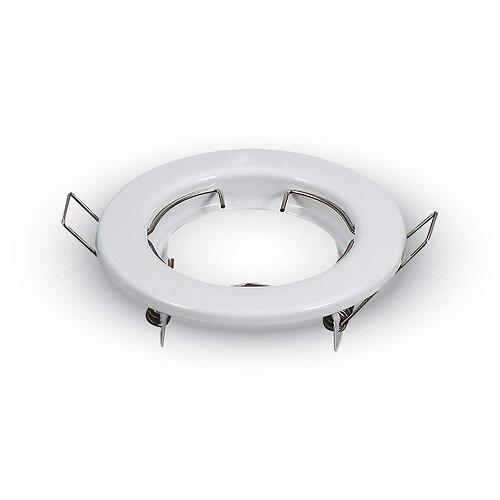Bro, I’m really impressed by your ceiling speaker setup! Could you share how you built it, especially your choice of components? Did you modify an existing ceiling speaker or build it completely from scratch?
Nope… I used a normal non-adjustable spotlight holder (the ones where you put the GU10 spotlights) A WS2812 circular LED with 12 LEDs (it has the exact same measurements as a GU10 spotlight so you can insert it inside the spotlight holder). Then I took a white net (the kind used for PCs and are semi-rigid) and cut it into the same circular shape.
The speaker is simply placed on the external mount of the spotlight holder. A simple 3W 4ohm.
The same configuration is also possible with the Respeaker but the “problem” is that it does not have adjustable microphones and therefore a larger spotlight holder would be needed and it would also be necessary to connect an external circular LED or leave the basic one facing downwards with the microphones.
There were also many other ways to install it with a spotlight holder to be recessed into the ceiling where the circular LED could be glued… perhaps more beautiful BUT this configuration allows me to remove the device without problems and without having to solder the cables to the ceiling.
Same problem here…
I have not updated to ESPHOME 2025.5.0… everything is as it was. When I press LOG in ESPHOME I get this error.
Until a few days ago I had no problems checking the log… today nothing. I have this error.
Seams PE repo does not contain this components any more.
And you do not need to declare it in external_components.
I leave only this
external_components:
- source:
type: git
url: https://github.com/formatBCE/esphome
ref: respeaker_microphone
components:
- i2s_audio
refresh: 0s
- source:
type: git
url: https://github.com/formatBCE/Respeaker-Lite-ESPHome-integration
ref: main
components:
- respeaker_lite
refresh: 0s
OT: I saw your project about the Koala-satellite… it is certainly very interesting but since I prefer to integrate the satellites in the ceiling I do not need all that configuration and that casing. I would also avoid the XMOS XU316 because it would take up too much space (and it seems to me that the configuration is acceptable even without).
Is your configuration also suitable for just the ESP32-S3 with speaker and microphone?
I think this is the closest configuration to the Respeaker but I’m not sure if it would work.
My repo already contains correct YAML. Also you have to use ESPHome 2025.5. That’s the way PE is working right now, and Respeaker follows. Almost all external components moved to mainstream ESPHome.
Regarding using Koala/Respeaker code for regular 1-mic setup (please stop calling it ESP32-S3, because Respeaker is also using ESP32-S3, it’s confusing ![]() ) - the code for Respeaker is assuming there’s 2 microphones (well, one, but with 2 independent channels). Microwakeword nowadays is using one microphone exclusively, leaving another to Voice Assistant. This allows using “stop” word, for example. With single microphone there’s no way to do it. So no, you can’t use that code directly. I believe your best bet would be to adapt the code for M5Stack Atom Echo, which has single microphone. (But i assume you already have it working?)
) - the code for Respeaker is assuming there’s 2 microphones (well, one, but with 2 independent channels). Microwakeword nowadays is using one microphone exclusively, leaving another to Voice Assistant. This allows using “stop” word, for example. With single microphone there’s no way to do it. So no, you can’t use that code directly. I believe your best bet would be to adapt the code for M5Stack Atom Echo, which has single microphone. (But i assume you already have it working?)
So that’s interesting,…
so you mean that 1 microphone only listens to the Wakeword and one listens to what we communicate in the Respeaker? Can you tell me which of the two Mic (they should be numbered 1 and 2). I ask for a possible installation and positioning
It’s not like one physical mic on Respeaker is dedicated to MWW and other to VA. It’s data channels. But for you it could be 2 separate mics, i guess.
DFU software on XMOS chip is using both physical mics for picking the signal, cleaning it, applying noise reduction and acoustic echo cancelation. Then it splits the signal to 2 channels. Here you can see microphone defining those 2 channels (stereo), and here MWW is using channel 1 (with amplification), while VA is using channel 0.
Also, MWW works better, if audio signal doesn’t have automatic gain control (AGC) applied, so guys from Seeed (similar to guys from NabuCasa) made channel 1 AGC-free.
This allows MWW to be active constantly, unlike on Atom Echo, that has to stop MWW and start it again after VA is done.
(post deleted by author)
I disagree, it works without issues.![]()
With the new release, I stopped disabling WW and added the activation of Stop-word at the response stage. And surprisingly, everything works as it should. Plus, with the logic for a real continued conversation.
Okay, that is really great news. I didn’t try it after 2025.5 - so my knowledge is outdated.
Did you try with Atom, or generic S3 and INMP mic?
I’m assembling a satellite on a standard ESP32 (can be considered an Echo), but it has serious memory issues, so I have to manage with a single audio pipeline and WAV format. In February-March, there were stability problems, but by April, everything was fine. As a voice terminal, it’s a decent device, but forget about music. I should try flashing it with the official Echo configuration and then check if it will work without disabling WW…
The previous message referred to the standard ESP32-S3 N16R8 devboard.


